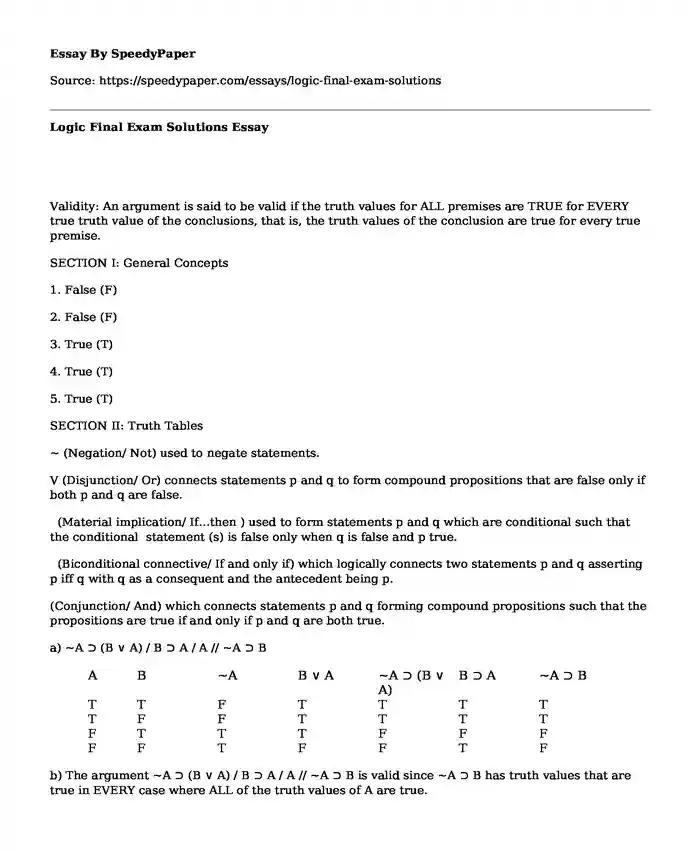
| Type of paper: | Essay |
| Categories: | Analysis Mathematics |
| Pages: | 3 |
| Wordcount: | 597 words |
Validity: An argument is said to be valid if the truth values for ALL premises are TRUE for EVERY true truth value of the conclusions, that is, the truth values of the conclusion are true for every true premise.
SECTION I: General Concepts
1. False (F)
2. False (F)
3. True (T)
4. True (T)
5. True (T)
SECTION II: Truth Tables
~ (Negation/ Not) used to negate statements.
V (Disjunction/ Or) connects statements p and q to form compound propositions that are false only if both p and q are false.
(Material implication/ If…then ) used to form statements p and q which are conditional such that the conditional statement (s) is false only when q is false and p true.
(Biconditional connective/ If and only if) which logically connects two statements p and q asserting p iff q with q as a consequent and the antecedent being p.
(Conjunction/ And) which connects statements p and q forming compound propositions such that the propositions are true if and only if p and q are both true.
a) ~A ⊃ (B ∨ A) / B ⊃ A / A // ~A ⊃ B
A |
B |
~A |
B ∨ A |
~A ⊃ (B ∨ A) |
B ⊃ A |
~A ⊃ B |
T |
T |
F |
T |
T |
T |
T |
T |
F |
F |
T |
T |
T |
T |
F |
T |
T |
T |
F |
F |
F |
F |
F |
T |
F |
F |
T |
F |
b) The argument ~A ⊃ (B ∨ A) / B ⊃ A / A // ~A ⊃ B is valid since ~A ⊃ B has truth values that are true in EVERY case where ALL of the truth values of A are true.
SECTION III: Rules of Replacement
1. Duplication 4. Equivalence 7. Commutativity 10.Implication
2. Negation 5. Simplification 8. Conjunction
3. Dilemma 6. Disjunction Introduction 9. Conditional Exchange
SECTION III: Proofs using Rules of Replacement
1.
1.) (1) (~M ⊃ P)(~N ⊃ Q)
2) ~(MN) /∴ P ∨ Q
(3) ~M ∨ ~N 2 Dem
(4) P ∨ Q 2 Imp
2. 2.) (1) R ⊃ ~B
(2) D ∨ R
(3) B /∴ D
(4) ~~B 3DN
(5) ~R 1,2 MT
(6) R ∨ D 2Com
(7) D 2,6DI
3.) (1) ~ ~ ~(O ∨ M)
(2) ~S /∴ ~M
(3) ~(O ∨ M) 1DN
(4) ~O~M 3DeM
(5) ~M~O 4 Com
(6) ~M 2-5 IMP
4.) (1) ~(~E~N) ⊃ T
(2) G ⊃ (N ∨ E) /∴ G ⊃ T
(3) (~~E ∨ ~~N) ⊃ T 1DeM
(4) (E ∨ ~~N) ⊃ T 3DN
(5) (E ∨ N) ⊃ T 4DN
(6) (N ∨ E) ⊃ T 5Com
(7) G ⊃ T 2IMP
SECTION IV: Proofs
a.) 1. M ⊃ (U ⊃ H)
2. (H ∨ ~U) ⊃ F / M ⊃ F
3. H ∨ ~U 2IMP
4. F 2MP
5. H 3SIMP
6. ~U 3SIMP
7. M 1 SIMP
8. M ⊃F
b.) 1. ~H ⊃ B
2. ~H ⊃ D
3. ~(B • D) / H
4. B • D 3IMP
5. B 4SIMP
6. D 4SIMP
7. ~H 1,5MP
8. ~ ~H 7DN
9. H
Cite this page
Logic Final Exam Solutions. (2018, Jan 31). Retrieved from https://speedypaper.com/essays/logic-final-exam-solutions
Request Removal
If you are the original author of this essay and no longer wish to have it published on the SpeedyPaper website, please click below to request its removal:
- Free Essay on Dr. Milgram Experiment: Obedience
- Historical Essay Example: Causes of World War 1
- Best Toys for Infants Development - Free Essay in Child Development
- Movie Piracy Essay Sample
- Essay Sample Comprising the Responses to the Posts on News Articles
- Honor in Shakespeare's Much Ado About Nothing
- Essay Example on Electric Automotive Drive
Popular categories




